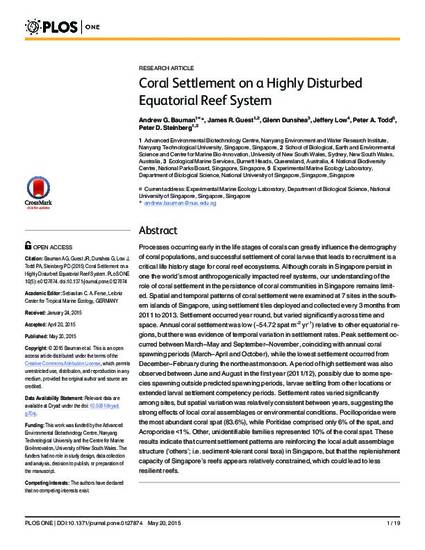
- Coral reefs,
- Corals,
- Larvae,
- Spawning,
- Singapore,
- Islands,
- Monsoons,
- Settlement Patterns
Processes occurring early in the life stages of corals can greatly influence the demography of coral populations, and successful settlement of coral larvae that leads to recruitment is a critical life history stage for coral reef ecosystems. Although corals in Singapore persist in one the world’s most anthropogenically impacted reef systems, our understanding of the role of coral settlement in the persistence of coral communities in Singapore remains limited. Spatial and temporal patterns of coral settlement were examined at 7 sites in the southern islands of Singapore, using settlement tiles deployed and collected every 3 months from 2011 to 2013. Settlement occurred year round, but varied significantly across time and space. Annual coral settlement was low (~54.72 spat m-2 yr-1) relative to other equatorial regions, but there was evidence of temporal variation in settlement rates. Peak settlement occurred between March–May and September–November, coinciding with annual coral spawning periods (March–April and October), while the lowest settlement occurred from December–February during the northeast monsoon. A period of high settlement was also observed between June and August in the first year (2011/12), possibly due to some species spawning outside predicted spawning periods, larvae settling from other locations or extended larval settlement competency periods. Settlement rates varied significantly among sites, but spatial variation was relatively consistent between years, suggesting the strong effects of local coral assemblages or environmental conditions. Pocilloporidae were the most abundant coral spat (83.6%), while Poritidae comprised only 6% of the spat, and Acroporidae <1%. Other, unidentifiable families represented 10% of the coral spat. These results indicate that current settlement patterns are reinforcing the local adult assemblage structure (‘others’; i.e. sediment-tolerant coral taxa) in Singapore, but that the replenishment capacity of Singapore’s reefs appears relatively constrained, which could lead to less resilient reefs.
Available at: http://works.bepress.com/andrew-bauman/22/

Data Availability: Relevant data are available at Dryad under the doi: 10.5061/dryad.g70nj.
Funding: This work was funded by the Advanced Environmental Biotechnology Centre, Nanyang Technological University and the Centre for Marine Bio-Innovation, University of New South Wales. The funders had no role in study design, data collection and analysis, decision to publish, or preparation of the manuscript.